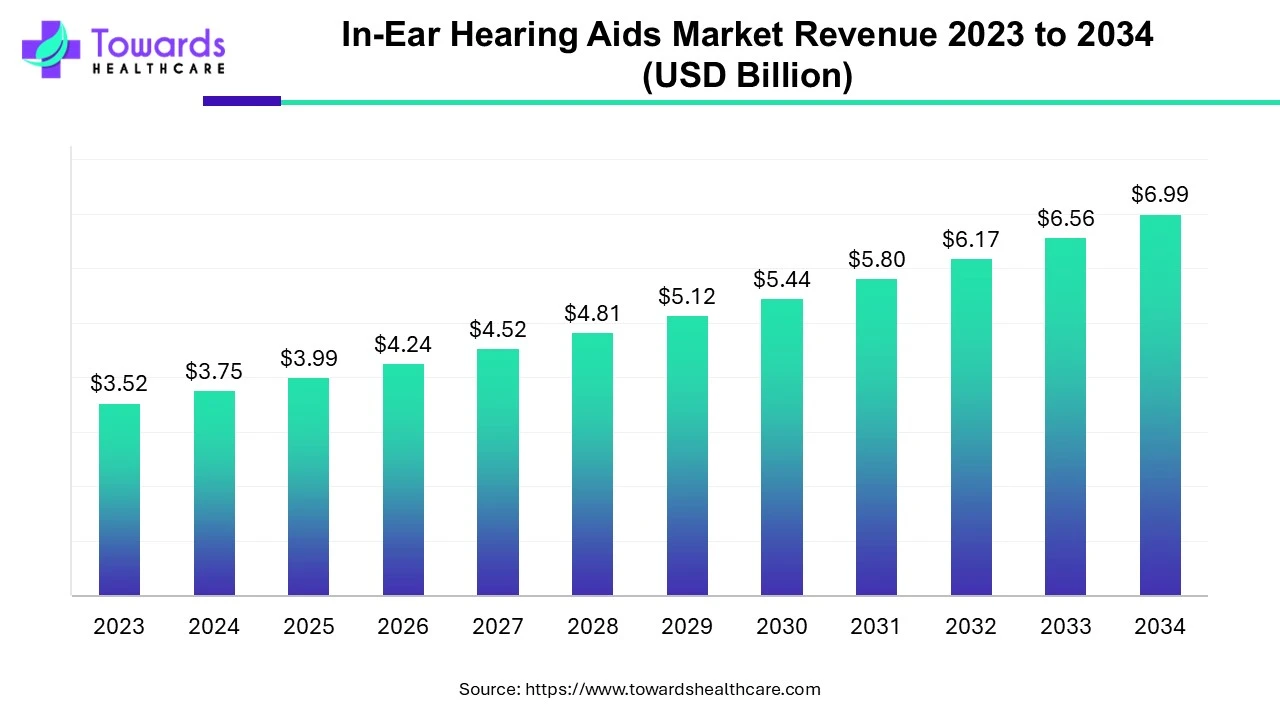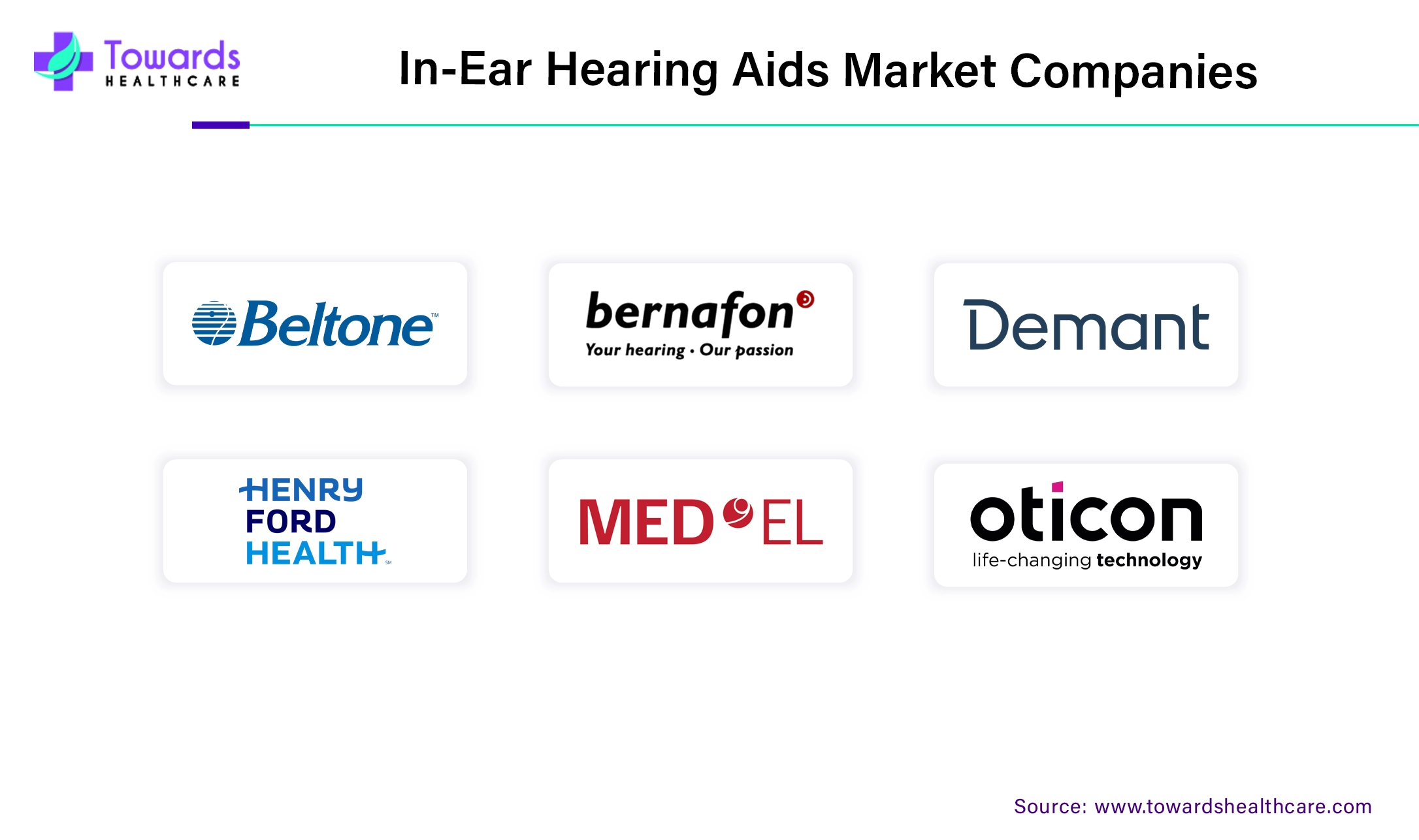October 2024


Principal Consultant

Reviewed By
The in-ear hearing aids market was estimated at US$ 3.52 billion in 2023 and is projected to grow to US$ 6.99 billion by 2034, rising at a compound annual growth rate (CAGR) of 6.43% from 2024 to 2034. The rising incidences of hearing loss, technological advancements, and favorable government policies.

Hearing aids are small devices worn behind or in the ear and enable hearing for people with hearing loss by making some sounds louder. The type of hearing aid depends on the patient’s level of hearing ability, visual and technological preferences, and lifestyle. In-the-ear (ITE) devices either fit completely in the entire ear or a portion of the bowl of the ear. They are often recommended for people with mild to severe hearing loss. The three main components of an in-the-ear hearing aid are a microphone, an amplifier, and a speaker. The rising incidences and prevalence of hearing loss necessitate the use of hearing aids among individuals. Additionally, technological advancements and the latest innovations in hearing aids enhance hearing ability and make it visually appealing, boosting market growth.
3D printing technology is a rapidly evolving technique used in various sectors globally, including healthcare. Several researchers and market companies are using advanced technologies to design and manufacture modern products with enhanced efficiency. 3D printing technology is used for designing and producing hearing aids. The technology enables the production of personalized devices based on the patient’s ear size. This is especially useful for pediatric patients whose ear sizes change gradually over time. Traditionally, fast-growing young children require multiple sets of hearing aids in their first five years. 3D printing can produce hearing aids of different sizes. Also, novel designs of hearing aids can be visually appealing according to the patient’s needs, fostering the demand for in-ear hearing aids.
For instance,
The high cost of an in-ear hearing aid is a major hindrance to the market. The average cost of an in-ear hearing aid ranges from $2,000 to more than $6,000. Also, they are usually not covered by insurance, restricting the use of in-ear hearing aids, especially by people in LMICs.
North America dominated the in-ear hearing aids market in 2023. The rising incidences of hearing loss, technological advancements, favorable government policies, and the presence of key players drive the market. Around 30 million Americans have some degree of hearing loss. According to the National Institute of Deafness and Other Communication Disorders, approximately 15%, i.e., 37.5 million Americans of 18 years and above, have some trouble hearing. About 1 in 3 people in the US between ages 65 and 74 have hearing loss, and nearly half of those older than 75 have difficulty hearing. The rising cases of congenital deafness are also a major concern. Around 2 to 3 out of every 1,000 children in the U.S. are born with detectable levels of hearing loss in one or both ears. Additionally, in a recent study conducted in Canada among people aged 40 to 79, 63% of men and 46% of women had measurable hearing loss. Several government programs, such as the Ontario Disability Support Program, offer financial support for hearing aids and related devices.
Asia-Pacific is anticipated to grow at the fastest rate in the in-ear hearing aids market during the forecast period. The rising geriatric population, rising incidences of hearing loss, growing research and development, and increasing investments & collaborations drive the market. It is estimated that around 6.3% of the Indian population has significant auditory impairment, accounting for 63 million people. In a 2024 epidemiological study, it was found that 1.62 per 1,000 newborns suffered congenital deafness. The rising geriatric population in China, India, and Japan are at a high risk for age-related hearing loss cases. Furthermore, the Chinese government is in the process of developing national reimbursement policies for people with hearing loss. The National Program on Prevention and Control of Deafness by the Indian Government spreads awareness through screening programs and provides diagnosis and treatment to hearing loss patients. It also provides free hearing aids for people with family incomes less than Rs. 6,500.
By type, the ITE-half shell segment held a significant share of the in-ear hearing aids market in 2023. A half-shell ITE hearing aid is a type of earmold that fits in the bottom half or third of the ear canal. It is usually more comfortable than full-shell and is used to treat mild-to-moderate hearing loss.
The ITE-full shell segment is estimated to grow at a notable rate in the in-ear hearing aids market during the forecast period. A full-shell earmold fits in the entire ear canal. It provides more amplification than half-shell as it covers the ear and is usually used for moderate-to-severe hearing loss cases. Also, they are larger than other in-ear hearing aids. Hence, they are easier for people facing dexterity challenges.
By application, the age-related hearing loss segment held the largest share of the in-ear hearing aids market in 2023. The rising incidences of age-related hearing loss due to the increasing geriatric population govern the use of in-ear hearing aids. The prevalence of hearing loss increases with age, and over 25% of people above 60 years globally are affected by disabling hearing loss.

By Type
By Application
By Region
October 2024